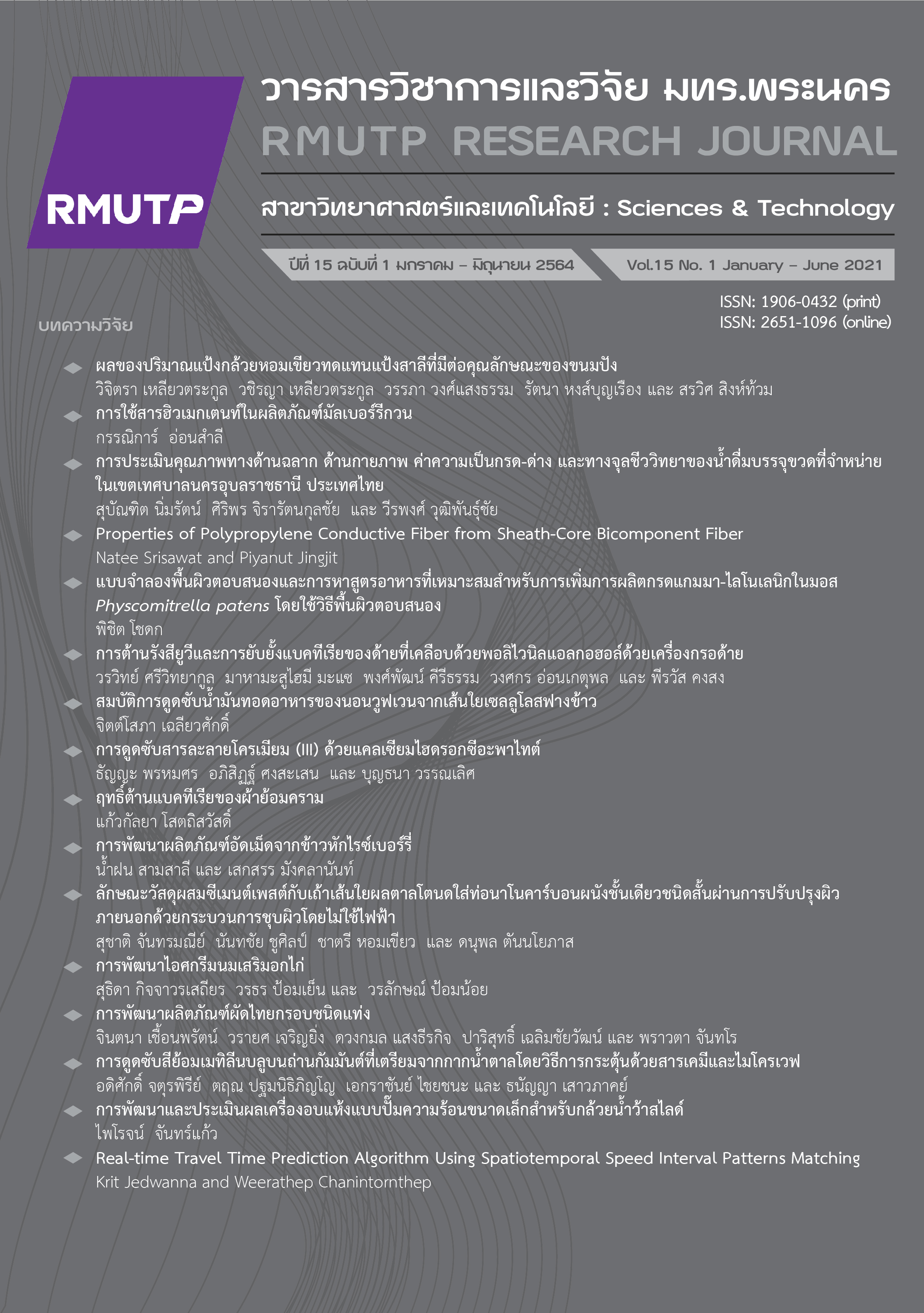การพัฒนาไอศกรีมนมเสริมอกไก่
Main Article Content
บทคัดย่อ
ไอศกรีมนมเป็นหนึ่งในอาหารหวานที่ได้รับความนิยมกันอย่างแพร่หลายในหลายประเทศ แต่ไอศกรีมนมส่วนใหญ่ประกอบด้วยน้ำตาลและไขมันสูง จึงเป็นเหตุผลที่ทำให้ผู้บริโภคที่ออกกำลังกายเป็นประจำกังวลถึงผลกระทบของการบริโภคไอศกรีมต่อปัญหาสุขภาพ และนำไปสู่ความต้องการในการพัฒนาไอศกรีมที่ให้โปรตีนสูงสำหรับผู้บริโภคกลุ่มนี้ ดังนั้นงานวิจัยนี้จึงมีวัตถุประสงค์เพื่อการพัฒนาไอศกรีมนมโปรตีนสูงจากอกไก่ โดยศึกษาปริมาณอกไก่ที่ระดับ ร้อยละ 5 10 และ 15 โดยน้ำหนักทั้งหมด ผลการศึกษา พบว่าไอศกรีมเสริมอกไก่ที่ระดับร้อยละ 10 เป็นระดับที่ให้คุณภาพทางกายภาพและคุณภาพทางประสาทสัมผัสที่ดีที่สุด โดยน้ำไอศกรีมมิกซ์มีค่าความหนืด 89.05 CSP มีค่าโอเวอร์รันร้อยละ 108.05 ค่าเนื้อสัมผัส 34,584 g force และอัตราการละลายร้อยละ 23 ส่วนค่าสีพบว่าความสว่าง (L*) ค่าความเป็นสีแดง (a*) และค่าความเป็นสีเหลือง (b*) มีค่า 87.10, 5.08, 20.54 ตามลำดับ
Article Details
เอกสารอ้างอิง
D.P. Donhowe and R.W. Hartel, “Recrystallization of ice during bulk storage of ice cream,” International Dairy Journal, pp.1209-1221, Feb. 2017.
J. Saengmanee, Value of Thai Chicken Meat. 1st ed. Bangkok: Office of Research Fund, 2009.
J. Burakarakorn, P. Pinthong, M. Rueangdit and P. Dangsungnoen, “Crispy low-fat chicken breast food products, ready to consume,” Journal of Department of Science Service, vol. 68, no. 211, pp. 24-25, 2019.
O. Chairod, Milk production technology Department of Food, 1st ed. Bangkok: Ramkhamhaeng University, 2001.
The Association of Official Analytical Chemists, 17th ed., Official Method of Analysis of AOAC International, 2000.
K.Chanaasit, P Mongkhon, and N. Daengsangwan, “The development of alovera ice cream yogurt Research report,” Research report. Phra Nakhon Si Ayutthaya, Rajamangala University of Technology Phra Nakhon, Thailand, 2014.
A. Akesowan, “Influence of Soy Protein Isolate on Physical and Sensory Properties of Ice Cream,” Thai Journal of Agricultural, vol. 101, pp. 713–727, Feb. 2017.
P. Noiduang and R. Wongwan, “Development of ice cream form from apple custard using powder. The mucus from the basil seeds is a stabilizer,” Journal of Food Technology Siam University, vol. 5, no. 1, pp. 36-46, 2010.
Q. A, Syed, S. Anwar, R. Shukat and T. Zahoor, “Effects of different ingredients on texture of ice cream,” Journal of Nutritional Health & Food Engineering, vol. 8, no. 6, pp. 422-435, 2018.
V. Tomer and A. Kumar, “Development of High Protein Ice-Cream Using Milk Protein Concentrate,” Journal of Environmental Science, Toxicology and Food Technology, vol. 6, no. 5, pp. 71-74, 2013.
N. Chaviwan, “Development of Dok Sesan ice cream products,” Research report. Phranakhon Si Ayutthaya, Phranakhon Si Ayutthaya: Rajabhat University, Thailand, 2013.
P. Suphawitphatthana. (2019, February 20). Defense College of Milk and Products Technology. [Online]. Available: http://www.eLearning.psru.ac.th


